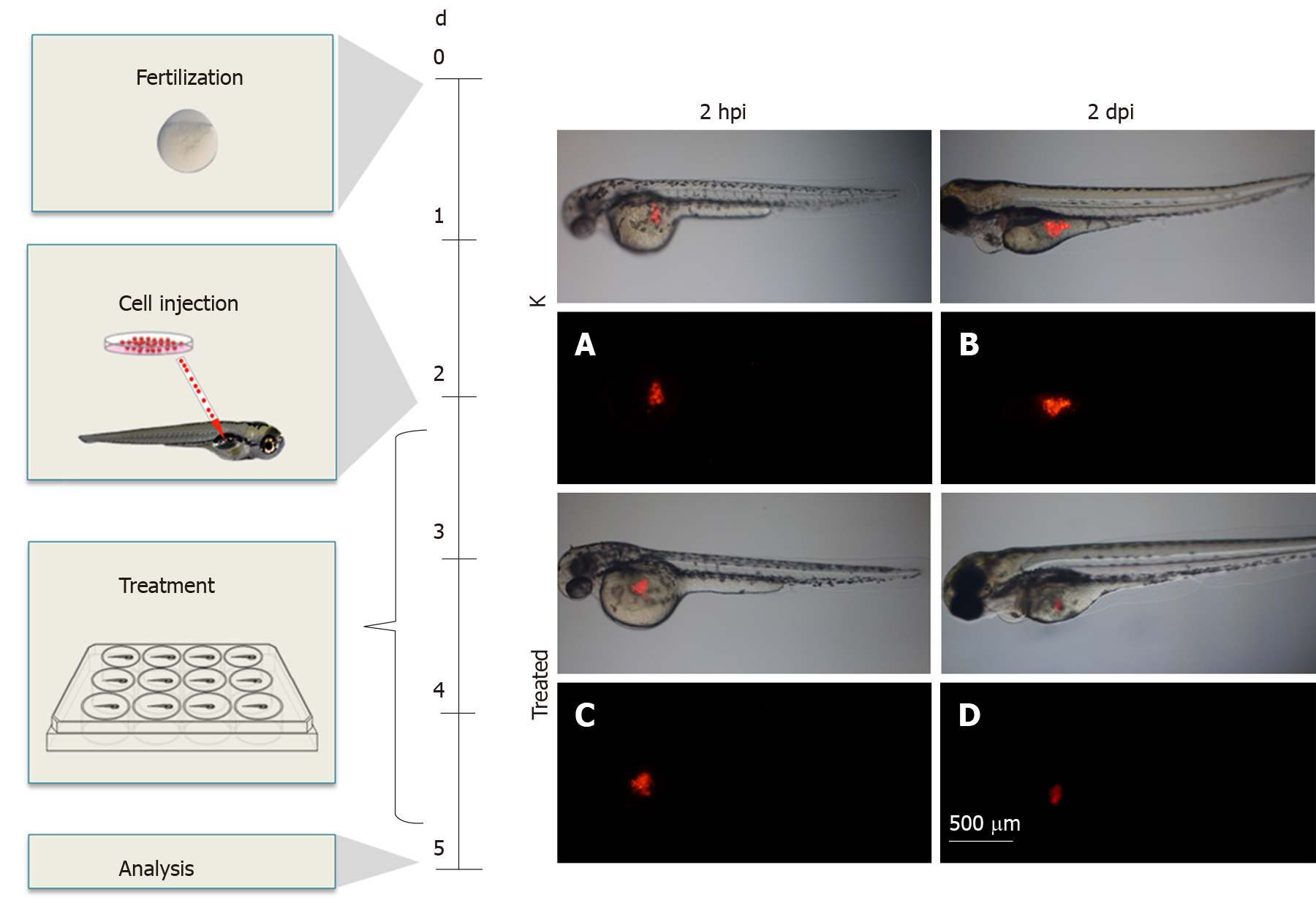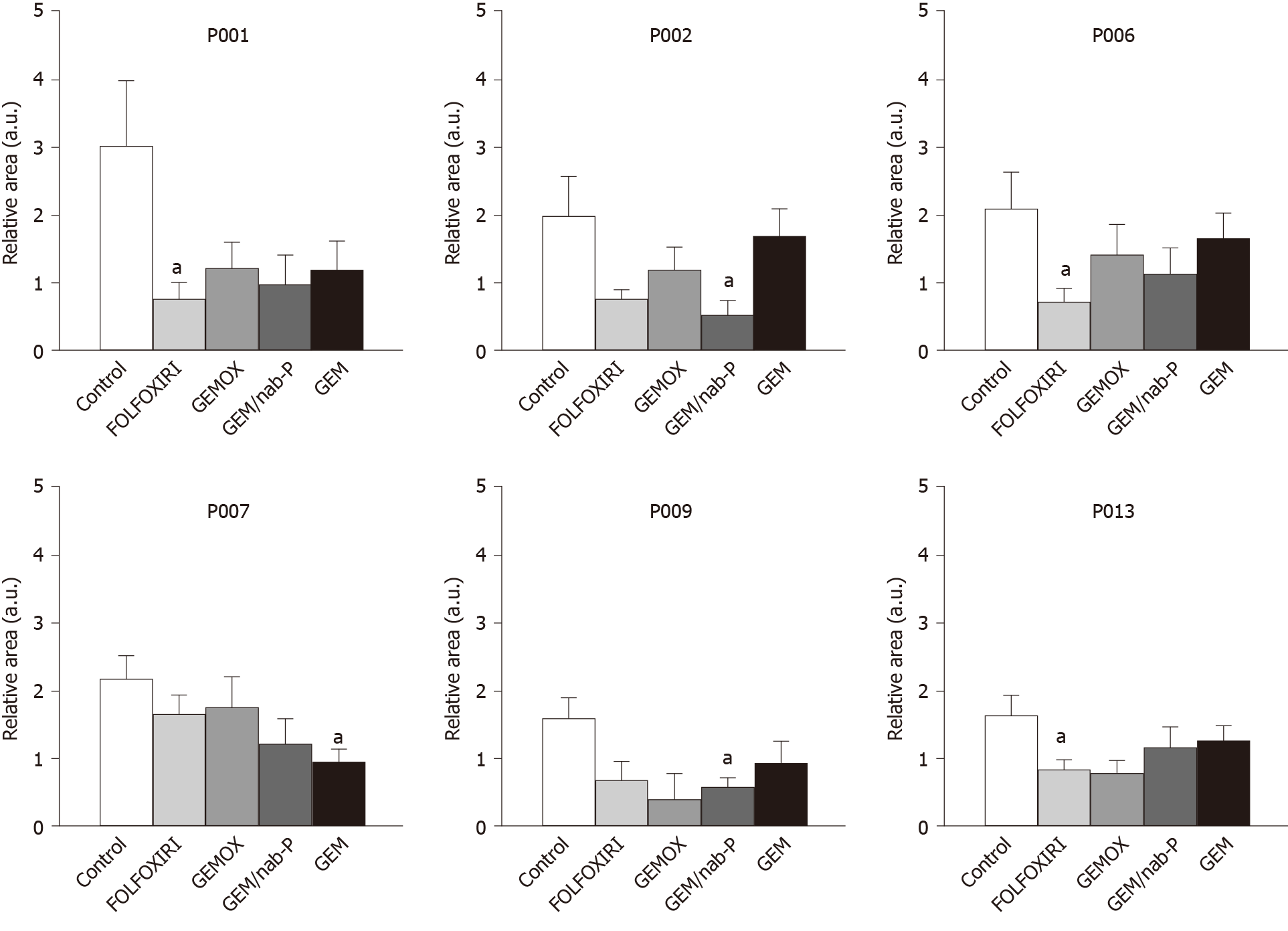Copyright
©The Author(s) 2020.
World J Gastroenterol. Jun 7, 2020; 26(21): 2792-2809
Published online Jun 7, 2020. doi: 10.3748/wjg.v26.i21.2792
Published online Jun 7, 2020. doi: 10.3748/wjg.v26.i21.2792
Figure 1 Protocol used for the evaluation of the chemotherapy drugs efficacy.
A piece of pancreatic ductal adenocarcinoma tumor tissue is injected into the yolk sac of zebrafish embryos 2 dpf. At 2 h post injection (hpi) the embryos are imaged and exposed to chemotherapy for 2 d. A and B: On the right panel a representative image of control embryos after 2 hpi and 2 dpi; C and D: On the right panel a representative image of treated embryos after 2 hpi and 2 dpi. Qualitatively images show the increased of fluorescent area in control group versus the regression in xenotransplanted embryos treated with chemotherapy.
Figure 2 Tumor tissue was successfully engrafted in healthy zebrafish embryos in all cases.
A: Surgical specimen was obtained from patient with diagnosed pancreatic ductal adenocarcinoma (PDAC); B: Two fragments of the tumor were taken; C and D: One of them was used for histological evaluation (C) revealing that the percentage of epithelial cells (mean PDAC counterpart) out of the total surface area is 31.8% ± 4.9% (n = 3) (D); E: The second fragment of the tumor was used for xenotransplantation into the yolk of zebrafish embryos 2 dpf. After 2 d post xenotransplantation, the zebrafish patient-derived xenografts (zPDX) are Formalin-Fixed Paraffin Embedded. We performed the hematoxylin and eosin staining and immunohistochemistry using anti-Human Pan-Cytokeratin antibody on zPDX sections, highlighting the presence of epithelial PDAC cells (orange arrows) and the immune-negative counterpart (black arrows) that might be associated with the microenvironment side of PDAC human tissue. PDAC: Pancreatic ductal adenocarcinoma; PDX: Patient-derived xenografts; PanCK: Pan-Cytokeratin antibody.
Figure 3 Representative hematoxylin and eosin stained sections of zebrafish patient-derived xenografts.
Visible morphologic alteration of the human pancreatic ductal adenocarcinoma nuclei (orange arrows) in zebrafish patient-derived xenografts exposed to Gemcitabine + nab-Paclitaxel and 5-Fluorouracil + Folinic acid + Oxaliplatin + Irinotecan could be associated with a chemotherapy damage. Control group shows normal nuclei (black arrows). GEM/nab-P: Gemcitabine + nab-Paclitaxel; FOLFOXIRI: 5-Fluorouracil + Folinic acid + Oxaliplatin + Irinotecan.
Figure 4 Cases with a statistically significant reduction of the mean relative tumor area for at least one chemotherapy scheme (the code below each diagram corresponds to the case number).
Results are expressed as average ± SEM, aP < 0.05, 1-way ANOVA followed by Dunnett’s multiple comparisons test. Control group shows normal nuclei (black arrows). GEM: Gemcitabine; GEMOX: Gemcitabine + Oxaliplatin; GEM/nab-P: Gemcitabine + nab-Paclitaxel; FOLFOXIRI: 5-Fluorouracil + Folinic acid + Oxaliplatin + Irinotecan.
Figure 5 Percentage of cases with a percentage reduction of mean relative tumor area equal or greater to each threshold value.
RTA: relative tumor area; Control group shows normal nuclei (black arrows). k: Control group; GEM: Gemcitabine; GEMOX: Gemcitabine + Oxaliplatin; GEM/nab-P: Gemcitabine + nab-Paclitaxel; FOLFOXIRI: 5-Fluorouracil + Folinic acid + Oxaliplatin + Irinotecan.
- Citation: Di Franco G, Usai A, Funel N, Palmeri M, Montesanti IER, Bianchini M, Gianardi D, Furbetta N, Guadagni S, Vasile E, Falcone A, Pollina LE, Raffa V, Morelli L. Use of zebrafish embryos as avatar of patients with pancreatic cancer: A new xenotransplantation model towards personalized medicine. World J Gastroenterol 2020; 26(21): 2792-2809
- URL: https://www.wjgnet.com/1007-9327/full/v26/i21/2792.htm
- DOI: https://dx.doi.org/10.3748/wjg.v26.i21.2792













